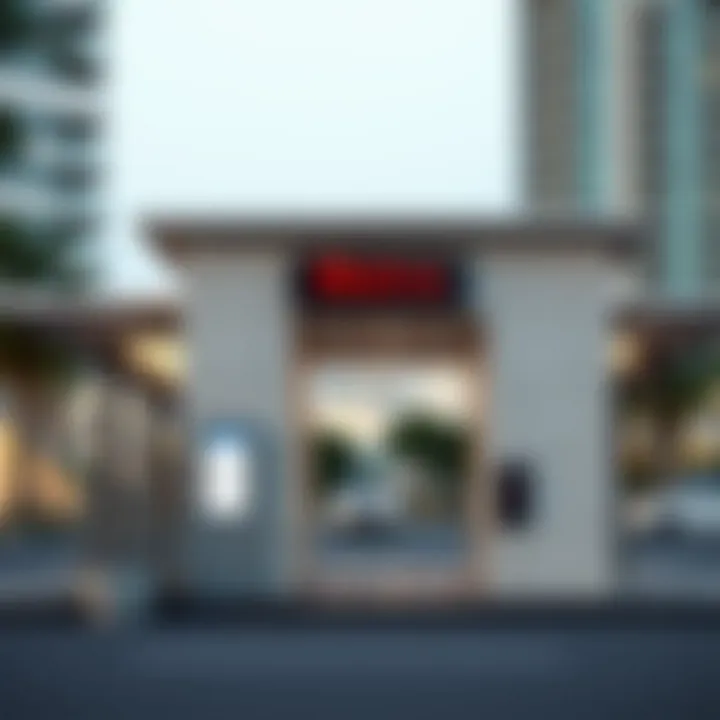Assessing Metro Station Proximity to Palm Jumeirah


Intro
Understanding the intricate relationship between metro stations and prime real estate locations such as Palm Jumeirah can provide crucial insights for investors and residents alike. This pivotal analysis not only highlights the significance of accessibility but also reflects the broader transportation dynamics that shape urban living in Dubai. Palm Jumeirah, with its luxurious lifestyle offerings, draws many individuals and families, making the proximity to efficient public transport a key factor in both daily commutes and property investments.
The discussion ahead focuses on pivotal aspects such as current trends in Dubai’s real estate market, the economic factors that influence property values, and the practical advantages of living near metro access points. By examining these facets, stakeholders can better navigate the complexities of investing in a rapidly changing urban environment.
Market Insights
Current Trends in Dubai Real Estate
As we dive into the analytics of the Dubai property market, it’s essential to note how public transport features in the rising demand for residential spaces. Recently, there has been a noticeable uptick in properties around metro stations, particularly those in key areas like Palm Jumeirah. Investors are keenly observing the shift towards integrated living spaces that prioritize ease of transport, reflecting a preference among residents for reduced travel times and enhanced connectivity with major city hubs.
Several factors contribute to this trend:
- Urban Development: Ongoing city projects consistently elevate the visibility and appeal of urban locations.
- Tourism Appeal: As one of the world's foremost tourist destinations, Dubai’s popularity drives demand for real estate in well-connected areas.
- Work-Life Balance: With the rise of remote work and hybrid models, many are seeking locales that blend leisure with convenient access to workspaces.
Economic Factors Impacting Property Values
Property values in Dubai are influenced by various economic elements, particularly those surrounding transport. Proximity to metro stations can notably enhance a property’s value, presenting a boon for investors. Key economic factors to consider include:
- Travel Accessibility: Easy access to major transport routes can lead to increased demand, boosting property prices.
- Affordability Trends: The fluctuating cost of living influences buying decisions. Proximity to affordable transport options can attract budget-conscious buyers.
- Infrastructure Growth: Investment in transport infrastructure often correlates with rising property values.
"In an ever-evolving city like Dubai, where amenities and accessibility go hand in hand, the right location can significantly affect property desirability."
The Impact of Proximity on Lifestyle
Living close to a metro station offers a multitude of advantages that extend beyond just convenience. In a busy place like Dubai, being near quality public transport can significantly enhance one's lifestyle.
- Time Savings: Reducing commute times allows residents to spend more time enjoying the attractions of Palm Jumeirah, rather than being stuck in traffic.
- Environmental Considerations: With a global push towards sustainability, public transport is a greener option compared to individual car usage.
- Community Engagement: Access to metro stations fosters a sense of community, offering varied leisure activities and interactions within the urban environment.
By grasping these crucial market insights, investors can make informed decisions that account for both current trends and future potentials in the proximity of metro stations to Palm Jumeirah.
Understanding Palm Jumeirah
Palm Jumeirah, often regarded as a symbol of modern engineering and luxury living, plays a pivotal role in the urban landscape of Dubai. This iconic island, shaped like a palm tree, isn't just a marshland of villas and luxury hotels; it represents a blend of innovation and ambition. For those diving deep into real estate or urban connectivity, understanding Palm Jumeirah's characteristics, history, and geographic relevance helps paint a picture of its significance within Dubai’s broader narrative.
Historical Background
The journey of Palm Jumeirah began in the late 1990s, when it was envisioned as part of a larger plan to revamp Dubai’s coastline. Developers harnessed the latest techniques in construction and land reclamation, leading to its official launch in 2001. Construction was no small feat; the project required massive investments and the dedication of numerous construction workers across the years. By 2006, Palm Jumeirah was essentially complete, giving rise to a variety of residential properties and recreational facilities. The accomplishment marked not only a new chapter in Dubai's architectural evolution but also a commitment to quality and luxury that has attracted a global audience. International allure is further fueled by developments like Atlantis, The Palm, which stands as a testament to its lavish lifestyle offerings.
Geographic Location
Nestled off the coast of Dubai, Palm Jumeirah extends into the Arabian Gulf. Its unique location makes it a coveted area, often described as a "premier address" for both comfort and leisure. The crescent surrounding the trunk of the palm provides crucial protection against harsh sea currents, enhancing its appeal for residential development. With close proximity to the mainland, residents benefit from easy access to Dubai’s dynamic urban life while enjoying a tranquil escape within the palm’s embrace. While the palm shape is visually striking, it also facilitates the development of beachfront properties, rendering them incredibly attractive to both residents and investors alike.
Significance in Dubai's Real Estate Market
As Dubai's real estate market continues to expand, Palm Jumeirah remains at its forefront. This area is not just another high-end neighborhood; it’s a fusion of touristic allure and residential prestige. Properties on this island typically appreciate significantly, making them hot commodities for investors. The sweeping waterfront views and dedicated amenities—like world-class dining, shopping, and entertainment—enhance this location's profile. Investors are often eager due to the flexibility of owning property in a region historically associated with high returns. Moreover, the community’s planning takes into account the convenience of nearby transport options, especially the metro stations that will be explored further in this article.
"The significance of Palm Jumeirah in the real estate market is akin to gold in a treasure chest; it’s rare, sought after, and holds immense value."
In summary, understanding Palm Jumeirah involves recognizing its historical significance, geographic advantages, and its crucial role in shaping Dubai's real estate economy. Investors and developers alike see the distinct opportunities this area presents, paving the way for informed decisions about property acquisition and development.


Public Transport in Dubai
Public transport plays a crucial role in the urban fabric of Dubai, significantly shaping how residents and visitors navigate this bustling metropolis. With its rapid growth and development, the importance of a robust transport network cannot be overstated, especially in relation to areas like Palm Jumeirah. Accessibility to metro systems can influence property values, investment opportunities, and the overall living experience in the city.
Overview of Dubai Metro
The Dubai Metro is not just a mode of transport; it's a lifeline for many. Launched in 2009, it has expanded into a network that efficiently connects various key areas across the city. This means that places like Palm Jumeirah aren't isolated but are instead linked to the broader metropolitan area.
- Modern Infrastructure: The metro boasts state-of-the-art trains and stations, leading to smoother and faster commutes.
- Safety and Convenience: With safety measures in place, the metro offers a reliable alternative to road travel, which can be plagued by traffic jams.
- Cost-Effective Travel: The fare system is designed to be affordable for most users, making it an attractive option for daily commutes.
The opening of Metro stations has marked a significant shift in commuting habits, encouraging residents to consider public transport as a viable option in their daily routines.
Integration of Public Transport Systems
A major strength of Dubai's public transport is its integration. The metro system works alongside buses, taxis, and ferry services to provide a seamless travel experience. Key elements of this integration include:
- Unified Fare System: Passengers can use a single Nol card for multiple modes of transport, simplifying payment processes.
- Strategic Connectivity: Metro stations are often located close to bus terminals, enabling easy transfers.
- Inclusion of Water Transport: Near Palm Jumeirah, water taxis and ferries integrate into the public transport system, offering unique routes and scenic views.
Such integration not only enhances the travel experience but also alleviates road congestion, encouraging a transition to more sustainable commuting practices.
Importance of Accessibility
When assessing the proximity of metro stations to Palm Jumeirah, accessibility emerges as a pivotal concern. The presence of nearby metro services can dictate property desirability and living standards. Here’s why accessibility matters:
- Property Value Impact: Properties close to metro stations are often viewed as more desirable, essentially driving up real estate values.
- Enhanced Mobility: Having a metro station nearby can reduce commute times significantly, allowing residents easier access to workplaces, malls, and recreational destinations.
- Attracting Investment: Property investors seek areas that boast good transport links. Easily accessible locations attract buyers and renters, further stimulating the local real estate market.
As noted by urban development studies, areas with high accessibility to public transport often see increased economic activity, which reinforces the idea that transport systems are essential for urban growth and development.
"Transport systems do not just connect places; they facilitate the social, economic, and environmental dynamics that breathe life into urban landscapes."
This understanding of public transport in Dubai—as an essential component—helps frame the significance of the metro's proximity to key areas like Palm Jumeirah, shedding light on the interconnectedness of transport and urban real estate dynamics.
Identifying the Nearest Metro Station
In the context of urban development, understanding how to identify the nearest metro station to key locations, such as Palm Jumeirah, is essential for both residents and investors. The proximity of a metro station can significantly affect accessibility, commuting times, and overall quality of life. When considering real estate investments or residence options in the vicinity of Palm Jumeirah, knowing which metro station to access and the amenities offered is a game changer. It can shape property values and influence decisions based on the convenience of transport options available.
Distance Measurement Techniques
To determine the closest metro stations to Palm Jumeirah, various distance measurement techniques can be utilized. The simplest method is straight-line distance, which measures the linear distance from a point (in this case, Palm Jumeirah) to potential metro stations, such as Dubai Internet City Metro Station, MOE Metro Station, and Al Khail Metro Station. However, given the urban layout, travel distance is often more pragmatic. This considers the actual routes traveled by public transport, factoring in roads, pedestrian pathways, and possible barriers.
Applying Geographical Information Systems (GIS) can also add precision in mapping out accessible routes. This technology helps visualize data and aids in assessing neighborhood infrastructure. Finally, time-based measurements have emerged as an important factor. Assessing travel times during peak and off-peak hours can provide a realistic perspective on accessibility, beyond mere kilometers.
Specific Metro Stations in Proximity
Focusing on specific metro stations can enhance our understanding of their contribution to the area's connectivity and convenience. Three key stations close to Palm Jumeirah warrant attention.
Dubai Internet City Metro Station
Dubai Internet City Metro Station is strategically positioned to serve tech-savvy professionals working in the nearby business hub. The station’s closeness to key corporate offices makes it a beneficial choice for daily commuters, streamlining travel for many who reside in Palm Jumeirah. One of its key characteristics lies in the ease of connectivity. This station supports a seamless transfer to various bus routes that extend into neighboring areas, making it a popular choice amongst residents who prioritize efficiency in transport.
However, while the station is highly functional, it can sometimes experience congestion during peak hours, affecting travel times. Additionally, the bus interchange can become crowded, which might deter some users.


MOE Metro Station
Situated near the Mall of the Emirates, MOE Metro Station draws shoppers, tourists, and residents alike. This station offers a unique feature: direct access to one of the largest shopping centers in the region. The beneficial aspect of MOE Metro Station lies in its foot traffic, as it provides access to various amenities, services, and entertainment options.
However, this station may be seen as slightly further away from Palm Jumeirah directly compared to others, yet its connectivity to a range of services compensates for that distance. The vibrant atmosphere around the station contributes to its charm but can also lead to busier and sometimes chaotic surroundings.
Al Khail Metro Station
Al Khail Metro Station presents yet another viable option for accessing Palm Jumeirah and its surroundings. A distinctive feature of this station is its focus on serving residential communities further out, catering to families and individuals who value neighborhood-centric living.
The key characteristic here is the tranquil environment, which contrasts sharply with the hustle found in busier stations. It usually has lower foot traffic, making it a beneficial choice for those looking for quieter commutes. However, it is important to note that some may find the need to rely on additional modes of transport to reach popular destinations, adding potential inconvenience, albeit with the benefit of peace and serenity during travel.
Travel Time Analysis
The time it takes to travel between Palm Jumeirah and the nearest metro stations is an essential aspect of urban mobility in Dubai. Public transport efficiency heavily relies on this analysis. It impacts residents’ daily commutes and investors’ decisions regarding property values. If travel times are minimal, it makes Palm Jumeirah an attractive location for households and businesses alike.
Travel time analysis encompasses various factors, including specific metro stations' proximity, traffic conditions, and metro schedules. By understanding these elements, commuters can choose the most suitable route, leading to reduced travel times.
Time Efficiency Comparisons
When comparing travel times from Palm Jumeirah to various metro stations, the focus is on efficiency. The average commute can take anywhere from 20 to 40 minutes, depending on which station one chooses. This variance creates a notable difference in daily life for commuters.
Factors influencing this include:
- Distance to Stations: Stations closer to Palm Jumeirah, like Dubai Internet City Metro Station, often allow for quicker access.
- Route Availability: The number of stops and the routes taken by metro lines can either shorten or lengthen journey duration.
- Real-time Data: Many commuters rely on apps that provide live updates, allowing them to decide which train to catch based on current conditions.
Factors Affecting Travel Duration
Traffic Patterns
Traffic patterns in Dubai contribute significantly to travel duration. During peak hours, the roads leading to metro stations tend to be congested.
- Characteristics of Traffic: Heavy traffic can add several minutes to travel time.
- Why This Matters: Understanding traffic patterns allows commuters to plan their journeys better, possibly by adjusting their departure times.
- Unique Features: Employing a mix of public transport options can also alleviate congestion during rush hours.
Metro Schedule
The metro schedule plays a crucial role in determining travel times. In Dubai, the metro generally runs from 6 AM to midnight on weekdays, allowing flexibility.
- Scheduled Frequency: Trains arrive every few minutes during peak times, which reduces waiting time.
- Importance of Predictability: A reliable schedule means commuters can minimize time spent in transit.
- Challenges: Delays can occur, but they are generally less common, especially if peak hour usage is managed efficiently.
Inter-connections to Other Transport Modes
Interconnections to other transport modes enhance overall travel efficiency.
- Benefit of Connections: Being able to switch from metro to bus services or taxis allows for seamless travel across the city, reducing overall travel time.
- Characteristics of Interconnections: Stations often include bus terminals or taxi ranks.
- Advantages/Disadvantages: While connections add time if waiting is involved, they can significantly cut down total travel duration if timed correctly.
"Time is money, especially in a bustling city like Dubai. Efficient public transport systems are crucial for keeping pace with urban growth."
Accessibility Features of Metro Stations
When discussing the urban landscape of Dubai, the accessibility features of metro stations become crucial in understanding not just the quality of public transport but also its impact on the surrounding areas, such as Palm Jumeirah. Accessibility in this context encompasses a broad range of factors, from the physical layout of metro stations to the services provided that ensure ease of use for all individuals, including those with disabilities. The design and facilities within these stations play a pivotal role in enhancing the overall commuting experience, making it essential to deeply analyze these features as they directly influence user behavior and satisfaction.


Facilities Available at Nearby Stations
The nearby metro stations to Palm Jumeirah, like the Dubai Internet City Metro Station and MOE Metro Station, are equipped with several facilities that cater to the diverse needs of commuters. These facilities include:
- Elevators and Escalators: Ensuring easy access for those with mobility challenges.
- Customer Service Desks: Staffed by trained personnel ready to assist riders with inquiries regarding routes, schedules, or ticketing.
- Restrooms: Adequate and clean restroom facilities are crucial for long commuters, adding to user comfort.
- Ticket Machines: Easily accessible machines for purchasing tickets, reducing wait times and queues.
- Seating Areas: Comfortable seating provides a brief respite for individuals waiting for their trains.
- Retail Outlets: Shops offering snacks, beverages, and essentials help to meet the daily needs of commuters.
- Clear Signage: Proper signage is essential for navigating the stations, especially for those who might not be familiar with the area.
These facilities not only enhance user convenience but also promote a sense of safety and satisfaction, contributing to a positive travel experience.
User Experience Considerations
User experience at metro stations significantly influences how often people utilize public transport. A metro station that prioritizes the comfort and convenience of its passengers can foster higher ridership rates, thus encouraging sustainable practices over private vehicle use. Considerations that affect user experience include:
- Accessibility for All: Stations must be designed to accommodate every user, especially those with disabilities, seniors, and families with young children. Features such as wide pathways, tactile guidance strips, and accessible ticket counters are necessary.
- Atmosphere: Cleanliness, lighting, and ventilation inside metro stations create an inviting atmosphere. A well-lit and maintained station feels safer to users.
- Information Availability: Offering real-time information about train schedules through digital displays helps users plan their journeys better.
- Integration with Other Transport Modes: The ease of transitioning from metro to buses or taxis is paramount. Stations that provide seamless connections can significantly enhance commuter satisfaction.
- Community Feedback Channels: Inviting user feedback can provide invaluable insights into how stations can be improved further to meet the needs of passengers better.
Incorporating these considerations not only serves the immediate needs of commuters but also plays a role in the broader urban development strategy, creating a more transport-efficient Dubai. As the city continues to grow, addressing these accessibility features will become increasingly important, helping to shape a more inclusive urban environment for all.
Impact on Real Estate Values
Real estate values in urban areas are intricately linked to public transport accessibility. As investors and buyers increasingly prioritize convenience, the proximity of metro stations becomes a critical factor in determining property prices. The effects of transport access can lead to both immediate and long-term shifts in real estate dynamics.
A critical aspect to consider is how easy commuting impacts daily living for residents. Properties that boast close distances to metro stations often enjoy higher demand. This demand translates directly into property appreciation, providing investors with lucrative opportunities. A quick glance at property listings around Palm Jumeirah shows a trend: units within a stone's throw of metro stations are often listed at higher prices than similar homes situated farther away. This correlation emphasizes the value placed on mobility and connectivity in a densely populated city like Dubai.
Moreover, areas with robust transport options not only attract buyers but also appeal to renters. For those looking to lease, a residence near efficient public transport can significantly reduce travel times and enhance the overall quality of life. According to various reports, properties near metro stations generally see higher occupancy rates. This statistic underscores the importance of transport access as a selling point in an increasingly competitive market.
Investors should also be keenly aware of the shifting landscape of real estate development around public transport systems. As the Dubai Metro network expands, new stations often lead to enhanced property market activity in their vicinities. This artificially inflates the surrounding areas’ value, as potential homeowners flock to take advantage of the transportation links.
“The connection of transport to property prices is undeniable. Proximity means not just a shorter commute, but a holistic enhancement of the lifestyle.”
In essence, analyzing the relationship between transport access and property pricing reveals critical insights for real estate stakeholders. The nature of urban living pushes the boundaries of what is considered desirable. For investors, understanding these connections can lead to informed and profitable decisions, positioning them favorably in the competitive Dubai market.
Correlation Between Transport Access and Property Prices
The correlation between transport access and property prices is an intriguing area for analysis. As mentioned earlier, properties that offer easy access to metro stations tend to command higher prices, driven mainly by the increasing demand for real estate situated near efficient transport links. Several factors contribute to this connection:
- Increased Demand: When public transport is readily available, more individuals are likely to consider residing in areas that are “well-connected.” This surge in demand often leads to price hikes, as sellers recognize their properties’ strategic value.
- Living Convenience: Easy access to metro lines enhances the daily life of residents, allowing for shorter and less congested commutes. This convenience is a significant factor for many buyers.
- Economic Growth: Regions benefiting from enhanced transport links often see economic development, attracting businesses and, in turn, boosting property prices.
A case study in the neighboring communities to Palm Jumeirah illustrates a pattern where increased metro accessibility has directly influenced property prices. As the metro lines expanded, followed by developments in residential and commercial real estate, property prices sharply ascended, demonstrating the direct impact of transport connections on market values.
Future Trends in Property Development
Looking ahead, there are several emerging trends in property development influenced by metro accessibility:
- Transit-Oriented Development (TOD): The concept is gaining traction where developers are prioritizing projects close to metro stations to create seamless access for residents. Developments that emphasize sustainable transport options, like proximity to transit hubs, are likely to attract those seeking convenience.
- Smart City Initiatives: As technology advances, emerging smart city frameworks might enhance the alignment of real estate development with existing and future transport networks, mirroring trends observed in western urbanization.
- Mixed-Use Developments: There’s a growing preference for mixed-use properties that integrate residential, retail, and office spaces within easy reach of metro stations. Such developments encourage walkability and lively community interactions, increasing their appeal to buyers and renters alike.
Culmination
The significance of examining the proximity of metro stations to Palm Jumeirah transcends mere geographical convenience; it ties into broader considerations of urban living, property investment, and lifestyle choices in a rapidly developing city like Dubai. Understanding this dynamic helps stakeholders, such as investors, residents, and urban planners, recognize how effective public transport solutions can enhance quality of life in one of the most sought-after locations.
Recent analysis reveals critical benefits that stretch beyond accessibility. A well-positioned metro station not only shortens travel time to key destinations but also boosts the attractiveness of Palm Jumeirah as a residential choice. This area, famed for its luxurious lifestyle and sea-view properties, sees an uptick in real estate values proportional to its proximity to transit options. Thus, commuter convenience becomes a vital driver in assessing property potential.
Summary of Key Findings
- Strategic Location Benefits - Metro stations such as Dubai Internet City and Mall of the Emirates significantly enhance accessibility for those living in Palm Jumeirah. Their strategic placement means reduced travel time to key commercial and leisure hubs.
- Travel Time Efficiency - The analysis shows that the average commute from Palm Jumeirah to major business districts via metro is shorter compared to ground transportation. The metro provides a reliable alternative, with fewer delays compared to road traffic.
- Real Estate Implications - Properties close to metro stations not only retain higher value but also attract a more diverse range of buyers or renters, particularly those valuing convenience.
Understanding transit access can lead to more informed decision-making for property investors.
Recommendations for Investors and Residents
- Invest in Properties Near Transit Points: When considering real estate in Palm Jumeirah, prioritize properties within walking distance of metro stations. This enhances appeal to future buyers or renters, given the ongoing growth of Dubai’s public transport network.
- Monitor Urban Developments: Keep an eye on future infrastructure projects and traffic studies that could impact access to metro stations. Shifts in public transport routes and timings can significantly influence property value.
- Prioritize Quality of Life Factors: For residents, choosing a home based on transport access should also include evaluating the overall lifestyle in Palm Jumeirah, including community amenities, leisure options, and social connectivity. This holistic approach maximizes comfort while ensuring easy commutes.







